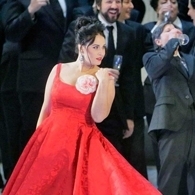Searching for the Real Traviata
Thursday, November 15 - 1pm | Mount Carmel Lutheran Church

You are undoubtedly quite familiar with Verdi's supreme opera - La Traviata. But do you know who the real Traviata was? This 3-session course will give you some understanding of the real person portrayed in the opera. The story of Traviata originates in the novel by Alexandre Dumas fils, La Dame aux Camelias. This novel inspired numerous stage dramas, 20 movies, several ballets and Verdi's great opera, which is currently the most popular opera worldwide.
The course will feature showings of Greta Garbo's grand 1936 movie, Camille, John Neumier;s classic ballet, with music by Chopin, Die Kameliendame, and Verdi's masterful La Traviata, all of which explore the life of the famous Parisian courtesan, Marie Duplessis.
Each Session meets at the Mt. Carmel Lutheran Church, 1701 Frederick St. in SLO - located at the intersection of Hwy 101 and Grand Ave, just off the Freeway.
All sessions run from 1- 4pm, Thursdays, November 1, 8 and 15
Each session includes a video segment from each of the operas and discussion. Participants receive a 28-page course syllabus with bios, synopses and commentary.
The donation is $15 for the entire 3-session course or $7 for a single session. All proceeds go to Support OperaSLO.
To register, send a check addressed to:
OperaSLO, PO Box 14760
San Luis Obispo, CA 93406
Checks or cash will be accepted at each session. (write “Traviata” on the lower left line of the check)
For specific questions and additional information please contact John Frey at JENFREY@aol.com or phone 805-549-0721.
Details on Each Class:
La Dame aux Camélias is a novel by Alexandre Dumas, fils, first published in 1848, and subsequently adapted by Dumas for the stage. The play premiered in Paris, France on February 2, 1852. The play was an instant success, and Giuseppe Verdi, who saw the play, immediately set about putting the story to music. His work became the 1853 opera La Traviata,. In the English-speaking world, La Dame aux Camélias became known as Camille and 16 versions have been performed at Broadway theaters alone in addition to 20 movies and 3 ballets. John Neumeier adapted his ballet from novelist Dumas's novel using of the music of Frédéric Chopin.
The Novel and Play: Alexandre Dumas fils - La Dame aux Camélias
On February 2, 1852, Dumas fils’ play La dame aux camélias was produced in Paris. It was an immediate success, made his name and became one of the most popular French plays of the 19th century. It was a landmark in the French theater as one of the first dramas to take contemporary life as its theme and as one of the first plays to show a courtesan in a sympathetic light; it was well-known that much of the play was based on the tragic life of the famous Parisian courtesan, Marie Duplessis.
November 1: The Movie: Greta Garbo - Camille
Camille is a lavish, melodramatic love/tragedy of Hollywood's Golden Age. It was adapted from Dumas fils' 1852 novel/play, La Dame aux Camelias, the tale of the doomed romance of a courtesan in 19th century Paris. Greta Garbo's portrayal of the beautiful but sickly Parisian courtesan, who fatefully falls in love with a young Frenchman is considered the definitive film version of the Camille story.
November 8: The Ballet: John Neumeier - Die Kameliendame
John Neumeier adapted his ballet from novelist Alexandre Dumas's La Dame aux Camélias making fervent use of the music of Frédéric Chopin. The work tells of a couple who meet while attending a performance of Manon Lescaut and then engage in a passionate but tragic love affair. The work was premiered by the Stuttgart Ballet on November 4, 1987. The ballet has since been performed by leading ballet companies worldwide and has become a 20th Century classic.
November 15: The Opera: Giuseppe Verdi - La Traviata
La traviata, is an opera in four acts by Verdi, inspired by Dumas, fils’ play which Verdi saw in 1852. The opera premiered at the Teatro la Fenice, in Venice, March 6, 1853. The title means literally “The Woman Who Strayed.” La traviata, owes much of its popularity to the heroine, Violetta, a tragic, beautiful, noble, young woman doomed to die an early death. The vocal demands of the role are formidable; the soprano must have brilliant coloratura, a long legato line and a convincing speaking voice. In Act I Violetta is a vibrant party girl madly in love with the dashing Alfredo. In Act II she is a serious young woman who gains the sympathy of Alfredo’s father. In Act III she is a bed-ridden consumptive whose last breath ends the opera.
